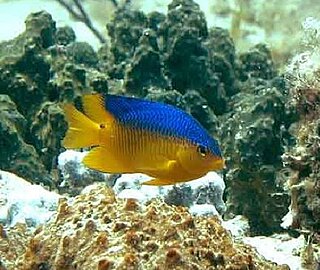
Pomacentridae is a family of ray-finned fish, comprising the damselfishes and clownfishes. This family were formerly placed in the order Perciformes but are now regarded as being incertae sedis in the subseries Ovalentaria in the clade Percomorpha. They are primarily marine, while a few species inhabit freshwater and brackish environments. They are noted for their hardy constitutions and territoriality. Many are brightly colored, so they are popular in aquaria.

The sergeant major or píntano is a species of damselfish. It grows to a maximum length of about 22.9 centimetres (9.0 in).
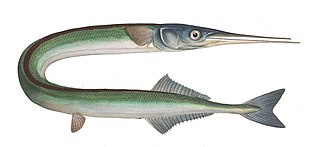
The garfish, also known as the garpike or sea needle, is a pelagic, oceanodromous needlefish found in brackish and marine waters of the Atlantic Ocean and the Mediterranean, Caribbean, Black, and Baltic Seas.

The alfonsino, also known as the alfonsin, longfinned beryx, red bream, or imperador, is a species of deepwater berycid fish of the order Beryciformes. It can be found in temperate and subtropical ocean waters nearly worldwide, though it is uncommon. It is typically associated with deep-sea corals, and schools are known to form over seamounts. Adults are demersal and search for prey along the ocean floor, primarily fish, cephalopods, and crustaceans. Like other members of its family, it is remarkably long-lived, with individuals reaching ages of up to 69 years, and possibly longer. It can reach sizes of up to 1 m (3.3 ft) in length and 2.5 kg (5.5 lb) in weight and is targeted by commercial fisheries. Its low reproductive rate and the time it takes for juveniles to mature make it vulnerable to expanding deep-sea fisheries, but it is listed as Least Concern by the International Union for Conservation of Nature (IUCN) due to its extensive range.

The Indo-Pacific sergeant is a species of damselfish in the family Pomacentridae. It may also be known as the Sergeant major although this name is usually reserved for the closely related species Abudefduf saxatilis. The closely related Abudefduf caudobimaculatus was formerly considered to be synonymous with this species and, according to some authorities, is synonymous.

The green damselfish, also known as the Hawaiian sergeant major, is a non-migratory fish of the family Pomacentridae. It occurs in the Pacific Ocean in the vicinity of the Hawaiian Islands, Midway Island and Johnston Atoll. It can grow to a maximum total length of 30 cm.

Cephalopholis taeniops, the African hind, bluespotted sea bass or spotted grouper, is a species of marine ray-finned fish, a grouper from the subfamily Epinephelinae which is in the family Serranidae which also includes the anthias and sea basses. This species occasionally makes its way into the aquarium trade and is a target for local fisheries. It is found in the eastern Atlantic Ocean.

The ornate wrasse is a species of wrasse native to the rocky coasts of the eastern Atlantic Ocean and the Mediterranean Sea. This species is of minor importance to local commercial fisheries, is also popular as a game fish, and can be found in the aquarium trade.

Scorpaena scrofa, the red scorpionfish, bigscale scorpionfish, large-scaled scorpion fish, or rascasse is a venomous marine species of ray-finned fish in the family Scorpaenidae, the scorpionfishes. It is found in the Mediterranean Sea, in the eastern Atlantic Ocean and the western Indian Ocean.

The Atlantic trumpetfish, Aulostomus strigosus is a species of trumpetfish in the family Aulostomidae. It is a tropical marine fish found in shallow coastal waters in the eastern Atlantic Ocean from Mauritania to Namibia. Like other trumpetfish, they eat mainly small fish and often shadow other piscivores while hunting.
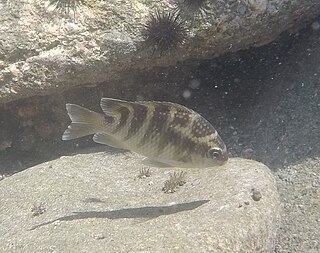
The dusky sergeant, also known as the night sergeant, is a species of damselfish in the family Pomacentridae endemic to the eastern Pacific Ocean. The species can reach 19 cm in total length.

Stegastes imbricatus, commonly called the Cape Verde gregory, is a damselfish of the family Pomacentridae. It is native to the tropical eastern Atlantic Ocean.
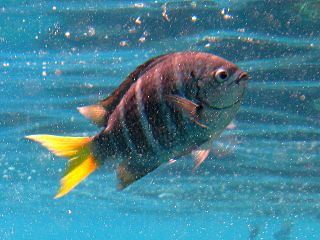
The yellowtail sergeant is a species of damselfish in the family Pomacentridae native to the Indo-Pacific. It can grow to a maximum total length of 17 centimetres (6.7 in).

Holacanthus africanus, the Guinean angelfish or West African angelfish, is species of marine ray-finned fish, a marine angelfish belonging to the family Pomacanthidae. It is found in the warmer sections of the eastern Atlantic Ocean off the coast of West Africa.
Merluccius polli, the Benguela hake, is a species of fish from the family Merlucciidae, the true hakes. It is found in the tropical waters of the eastern Atlantic Ocean off the west coast of Africa.
Chromis lubbocki is a species of marine fish of the family Pomacentridae. This fish grows to 12.5 cm maximal length. It occurs in the eastern Atlantic Ocean, off the coast of Cape Verde. The specific name honours the marine biologist Hugh Roger Lubbock (1951-1981) who led the Cambridge Expedition to Saint Paul's Rocks, part of the Cape Verde Islands, who collected the type specimen and realised it was a new species.
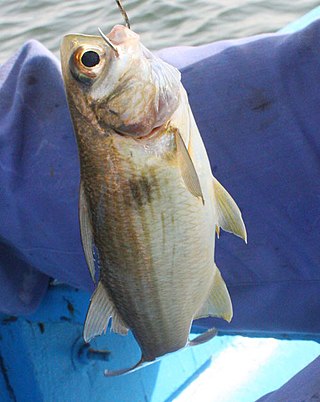
The lesser African threadfin is a species of marine ray-finned fish, a threadfin from the family Polynemidae which is found in the eastern Atlantic Ocean off the western coast of Africa.
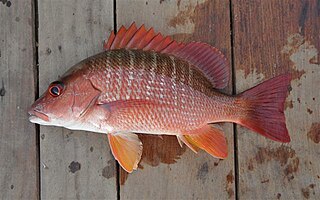
The Gorean snapper is a species of marine ray-finned fish, a snapper belonging to the family Lutjanidae. It is found in the eastern Atlantic Ocean.

Abudefduf taurus, commonly known as the night sergeant, is a species of damselfish in the genus Abudefduf.The species was originally described by Johannes Peter Müller and Franz Hermann Troschel in 1848. It is a large damselfish, reaching 25 cm in total length.
Abudefduf hoefleri, commonly known as the African sergeant, is a species of damselfish in the family Pomacentridae. It is native to the eastern Atlantic Ocean where it ranges from Senegal to Benin, including Cape Verde, Ilhéu das Rolas, and São Tomé Island. It is a littoral species typically encountered in rocky reef environments. The species is oviparous, with individuals forming distinct pairs during breeding and males guarding and aerating eggs. Abudefduf hoefleri reaches 20 cm in total length.




















